Magazine
The Journal of the
Religious and Spiritual Teaching of Da Free John

May/June
1980

Bhagavan
Nityananda
By Meg Krenz
(pictures added by
Beezone)
In India there have been many men
and women recognized for their complete surrender to God and
their wild freedom born from such surrender. These people
are called “avadhoots,” meaning “those who have given up
everything.” The ideal of the avadhoot is to yield every
vestige of self, doctrine, and social convention, and to
accept every arising circumstance as Divine instruction and
grace. Thus for the avadhoot everything is seen as God, and
his or her response to any situation is typically
spontaneous, free of all limitations and wholly aligned to
Divine Will. Although many people have been associated with
this traditional form of practice and realization, few of
them have become well known, especially in the West. Of the
handful of true avadhoots who have become known in recent
times, perhaps the greatest and most influential was Swami
Nityananda of South India.
Swami Nityananda, called Bhagavan
(Lord) by his devotees, dwelled in perfect Identity with
the…SeIf of all beings. Throughout the sixty-odd years of
his life (which ended in 1961), Bhagavan Nityananda lived as
the Self of all to every being who came to him. He was given
up in the paradoxical wildness of God and lived freely in
the world, untouched by the conventional limitations,
desires, and identifications suffered by common men and
women.
Because Swami Nityananda
enjoyed such radiant freedom in life, his behavior,
at least by modern Western standards, would often
appear bizarre and extreme. Indeed, had he appeared
in America, he may have been locked up as a
lunatic. In fact, this almost happened to him-even
in India, where there is cultural precedence for
such beings. Eventually, though, Nityananda was
recognized as a Divine Incarnation. In time,
thousands of people came to have his darshan
(sighting). Through this darshan alone, Swami
Nityananda initiated his devotees into Communion
with the Divine Power and Presence that Permeated
and Radiated from his human form.
He did not write books, go
on lecture tours, or create a spiritual
organization to propagate his teaching. He did,
however, make himself available to thousands of
people who revered him as Spiritual Master. Also,
as described later in this article, Bhagavan
Nityananda served the awakening of higher mystical
experience leading to Self Realization in the
spiritual practice that spontaneously arose in the
early life of Da Free John.
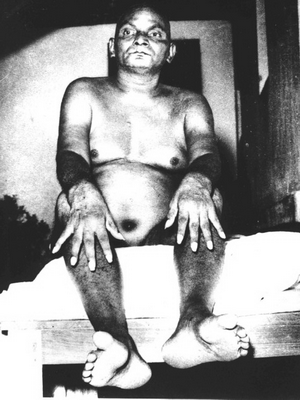
In recent months, a member of our
Church traveling in India was fortunate to speak with
Captain
Hatengdi, a longtime devotee
of Swami Nityananda. Captain Hatengdi was five years old
when his mother first took him to see Swami Nityananda.
During his childhood the young Hatengdi would occasionally
glimpse Nityananda sitting in the tree tops near where he
lived. But the Captain’s mother became interested in other
things and no longer took her son to visit the Swami. Then
years later, while stationed at a military base in Bombay,
Captain Hatengdi heard, of a man living in nearby Ganeshpuri
who reminded him of Nityananda. He went to Ganeshpuri and
found Nityananda living in the jungle. None of the local
people were aware of Nityananda’s unique presence there, and
so for three years, from 1944 to 1947, Captain Hatengdi
would spend every weekend alone in the jungle with
Nityananda.
The stories that the Captain told
our friend in India, which are published here for the first
time in the West, are priceless jewels which convey the
transcendental nature of Bhagavan Nityananda’s wisdom and
play with devotees. Because the major portion of
Nityananda’s spoken teaching has been lost due to the
illiteracy of his early following and his own indifference
to becoming a public figure, they are especially valuable.
Captain Hatengdi was a storehouse of anecdotes about
Nityananda’s life with devotees.

Although these stories are told in a
roughly chronological manner, they should not be taken as a
definitive biographical presentation of Swami Nityananda’s
life. There must be hundreds of such stories that devotees
tell about their Master’s Divine Play. The stories that we
present are a sampling of those compiled by one devotee. A
similar sampling from another source would undoubtedly
produce a number of other stories or even variations of
those presented here. Captain Hatengdi has tried to verify
each of these stories with other sources but discrepancies
are sure to arise. We hope to produce, with the help of
Captain Hatengdi and others, a comprehensive book of
Nityananda’s life which has thus far remained largely
unknown in the West.
For now we are pleased to have the
opportunity to print these stories that so clearly convey
the spiritual genius of a man intoxicated by the Divine.
They illustrate the wild and yet compassionate way in which
the Spiritual Adept relates to the world. Throughout
Nityananda’s life he was absorbed in the Presence of God,
and he was profoundly moved to awaken that Realization in
others. His actions always moved people beyond their
conventional assumptions about existence and into
relationship with the Divine Being that he
Incarnated.
The Early Years

Little is known about Swami
Nityananda’s birth and early life. He refused to respond to
any queries regarding his life, or even to refer to himself
as “I.” Instead he would call himself “this one” or “this
body.” Even so, from the earliest photographs of Nityananda,
he was obviously awake to the Living Power of
God.
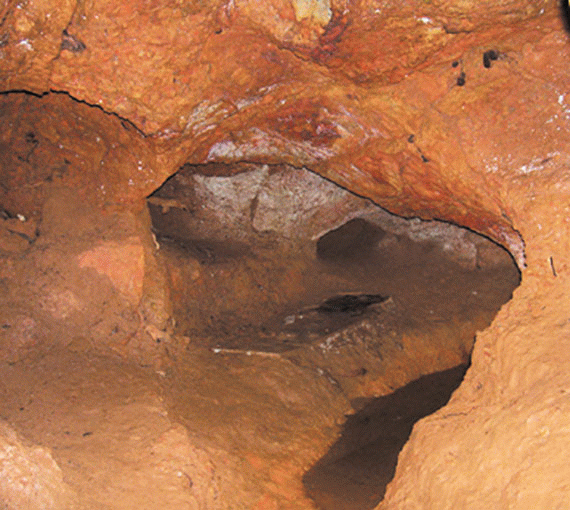
Nityananda’s Early Cave
of
It is believed by Captain Hatengdi
that he quietly left his home as a young boy and took up a
wandering life of austerity and meditation, spending six
years in a cave in the Himalayas and later living in tree
tops or other caves in the same district. Nityananda had no
need of such austere practice for his own sake. He engaged
these practices as an example and inspiration to all
spiritual aspirants. In fact, years later, when a woman
found him resting with his-eyes _ closed and commented to
her neighbor that he must be meditating, he replied, “All of
that was done in the mother’s womb,” implying that he had
realized perfect union with God before his physical
birth.
According to the Captain, Swami
Nityananda first revealed himself near Kanhangad in the
South Kanara District in Southern India. He was about
eighteen or twenty years old. He stayed in a remote cave,
absorbed in profound union with the Divine. Even then he
generated miraculous cures and emanated a profound spiritual
presence.
While sitting in trees, Swami
Nityananda would often pick and crumble leaves and drop them
to the ground. Many healings were attributed to the leaves
he blessed in this manner. Captain Hatengdi told a story of
one skeptical Christian family who decided to experiment
with these leaves. The grandmother, suffering from the same
disease as the mother, was given one of the leaves blessed
by Nityananda. She recovered immediately, while the mother,
who did not receive one of the leaves, grew deathly
ill.
Because of -his wild behavior in his
early life, Nityananda was some times taken for a madman.
Often young boys pelted him with stones, but they would
change into sweetmeats and fall to the ground. Often,
Nityananda wandered around naked in these early days, and,
on one occasion, was accosted by the local citizens who were
irate at his nakedness. They reported Nityananda to the
magistrate, who tried to convince him to wear a loin cloth.
But Nityananda responded, “Cover what? With what?” Finding
it useless to argue, the magistrate ordered the police to
tie a loin cloth on Nityananda. Three or four times they
tried, but each time the cloth slipped to the floor.
Embarrassed by this public display, the magistrate called
one of Nityananda’s devotees, who was a tailor. The devotee
approached Nityananda reverently, imploring him to wear the
loin cloth “for my sake.” Only then would the garment stay
in place.
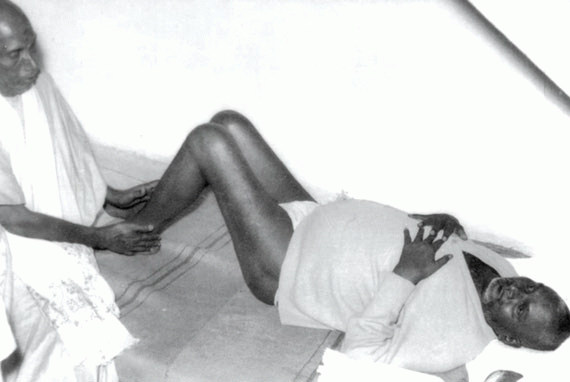
One time, while Nityananda was lying
on a large rock outside a temple near Kanhangad, a man began
to pester him, saying, “Show me God. You are such a great
saint, show me God.” Nityananda struck the man on the toe
with his umbrella, thereby rendering the man unconscious.
When the man came to, he rushed to a doctor and demanded
that he certify that Nityananda was mad and should be
arrested. Because Nityananda had no witnesses, he was locked
up. After an hour in jail, Swami Nityananda began to play
with his captors. He told the policeman on duty that he
needed to urinate, so the policeman brought him a small mug.
Soon it was overflowing. So he brought another, which was
quickly filled. Then the policeman began to resort to large
earthen pots, which were also filled. Finally, to be free of
the task of emptying this endless stream of pots, the
policeman let him go. Swami Nityananda wandered back to the
rock to lie in the sun once more. As a strange addition to
this story, when the doctor returned home, he found his wife
dancing madly around the house She was exhibiting all the
symptoms of insanity that he had certified in
Nityananda.
During these early years, Swami,
Nityananda simply wandered around in Kanhangad, generally
staying away from groups of people. The local children,
however, were always welcomed by Nityananda, and he spent a
good amount of time with them. He allowed only children to
touch him, although he did allow adults to feed him.
Typically he would show-up at random hours at various
devotees’ houses, where they would feed him. He would
sometimes speak and sometimes remain silent, and if it was
nighttime, he would sleep on the doorstep or in the
cowshed.
On one such day in the early 1920s,
Nityananda gave one of the most humorous teaching
demonstrations told to us by Captain Hatengdi, Swami
Nityananda appeared early one morning at a housing complex
where devotees lived. In those days there was no indoor
plumbing, so everyone simply relieved themselves on the
floor of one room. Each morning someone would come in and
scoop up the “night soil” and dispose of it. On this
particular morning Swami Nityananda came into the “bathroom”
quite early and picked up two large piles of excrement. He
carried them outside, sat in the middle of the compound, and
began to smear the feces all over his body and occasionally
eat pieces of it.
The devotees living in the compound
were shocked. Why was their Master acting so strangely? He
would offer them pieces of excrement from his pile, telling
them how delicious it was. As the day passed in this manner,
they began to fear that he would come into one of their
houses and soil the furniture. Finally, that evening he did
come inside but the devotees managed to clean him before he
sat down. At no time did Nityananda offer any explanation
for his behavior.
However, the next day two people,
who occasionally came to see Nityananda but were not
devotees, walked up and bowed at his feet, begging for
forgiveness. This only confounded the devotees even more.
They pulled the two men aside and demanded to be told why
they were apologizing to the Master. The men confessed that,
two days before, they had been standing outside the compound
discussing Nityananda’s typically strange behavior. One man
was commenting that Nityananda only ate what was offered to
him by devotees. The other replied, “Well, if this is so,
what if he was given shit? Would he eat that as well?” The
two men laughed at their joke and then left. But when they
saw Nityananda lying in the street eating excrement, they
were horrified and full of remorse that he had heard their
conversation. Swami Nityananda had responded in his
typically direct and selfless manner, demonstrating that he
was indeed submitted to his devotees.
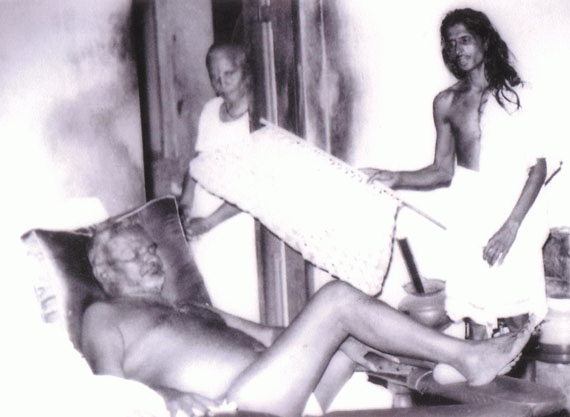
On another day, in 1922, his
devotees witnessed a dramatic revelation of his Divine
Nature. Twenty-five or so devotees had gathered for
meditation at seven o’clock in the evening. Suddenly they
discovered Nityananda in their midst, crouching and
straining, looking as though he were going to vomit.
Instead, they saw a huge flash of light around his form.
When they approached Nityananda, all signs of life had left
his body, which was quickly growing stiff. Immediately word
went out that the young Master had entered
mahasamadhi.1 The devotees watched over
Nityananda all night. No one touched the body and no doctor
was called in. However, they did hold cotton near his nose
to see if there was any breath, but none was detected.
Suddenly, at four o’clock in the morning, Nityananda began
to move.
Completely startled, his devotees
placed him on a bed and stretched his limbs. When they put
questions to him, Nityananda responded almost incoherently,
saying, “The time has not yet come. This one came a little
out of place and out of time. The time is not yet. Nobody
appreciates and understands the things he does. So he wanted
to discard the body and go. But a few sages met and they
told this one, ‘You go back. You have taken the body, why
not use it up?’ Let’s see, Ramakrishna was there,
Vivekananda was there. . .”2 He mentioned five
names, but the people who were around him could not remember
them all. In five-minutes he was fully conscious, and would
answer no more questions.
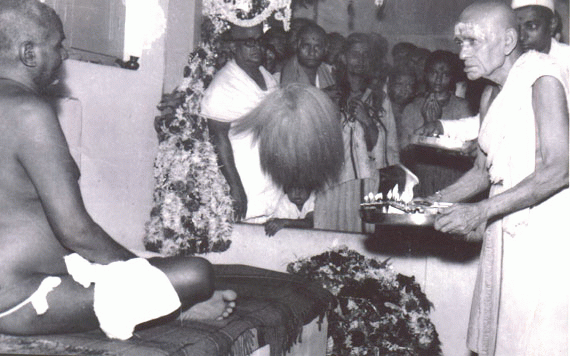
Swami Nityananda often spoke
ecstatically of his relationship to God. He sometimes began
his inspired discourses by saying, “0, Uncle Arjuna, listen;
Grandfather Krishna speaks.”3 Although he could
neither read nor write, his ecstatic speech contained
insight into human nature and religious practice that
reflected a prior, Divine Wisdom. It was during this early
period that the only book of his speech, Voice of the Self,
was recorded. However, because many of the people to whom he
spoke were also illiterate, much of his spiritual
instruction has been lost. In addition, he was often found
speaking when there was no one there listening at
all!
Once some devotees saw Swami
Nityananda sitting near a tree with a cobra. He was patting
the snake on the head, saying, “Are all three of you
comfortable in that tiny little space?” (Meaning Brahma,
Vishnu, and Shivathe Hindu trinity of the Creator, the
Sustainer, and the Destroyer.)
There are several stories about
Swami Nityananda requiring people to follow his instructions
precisely, but perhaps none more graphic than the
following:
One night Nityananda found a local
shopkeeper following him as he walked. He shouted at him to
go back and never follow him again. Eight days later the
shopkeeper, unable to control his curiosity, again followed
Nityananda. This time the man saw Nityananda cross the river
to speak with a tall, mysterious figure. The shopkeeper
realized that he had violated something and hurried home.
The next day Nityananda found him alone and told him never
to divulge what he had seen. But the shopkeeper was again
unable to discipline himself, and a week later he told his
wife what he had seen. He went insane the moment he finished
speaking-an immediate repercussion for having twice
disobeyed Swami Nityananda.
Another story from these early days
is told about three Muslims who knew Swami Nityananda but
were not his devotees. They were returning from a pilgrimage
to Mecca when they stopped by his ashram in Kanhangad to pay
their respects. When Nityananda asked them what they had
seen in Mecca, they told Nityananda they had seen him there,
and yet he had never left Kanhangad.
Some years later, in about 1930,
when Swami Nityananda was walking at midday, two assailants
tried to stab him. These men had been hired by a wealthy man
whose only son had left school to follow Nityananda. Since
Nityananda walked faster than anyone else, there was no one
by his side to protect him. Finally a policeman arrived to
arrest the attackers, but one of the assailant’s arms had
frozen in the air. He began to scream, and begged to be
released-Re could not move his arm, and it was becoming
extremely painful. When Nityananda reached up and touched
the man’s arm, down it came. Sometime later,’ after the man
had been jailed and a foolproof case had been established
against him, Swami Nityananda demanded that the man be
released. The local authorities, however, did not feel that
they could release him. Swami Nityananda then stationed
himself on the steps outside the courthouse, saying, “No
food need be served until the man is let out.” . After three
days of watching Nityananda refuse food and drink, the
police released the prisoner, who later became a devoted
follower of Nityananda.
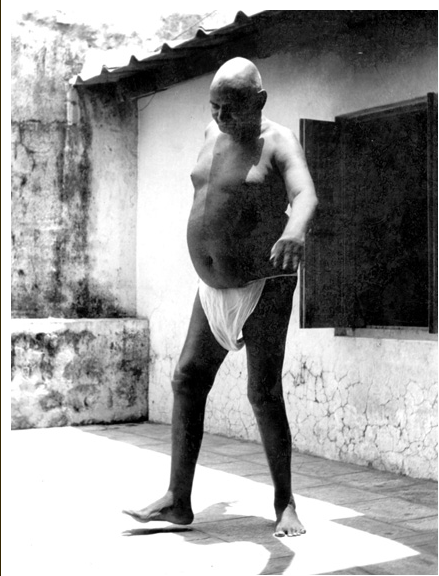
Ganeshpuri The Later
Years
One day Swami Nityananda suddenly
abandoned the ashram-at Kanhangad and wandered throughout
India for several years. His devotees lost track of him
during this period Nityananda reappeared at Ganeshpuri, a
remote spot near Bombay several hundred miles northwest of
Kanhangad. At first no one recognized him as an avadhoot,
but gradually the local people realized that this man was a
great spiritual figure. Over time he became well known in
the area, and an ashram and an entire village were built
around him.
As stated above, Captain Hatengdi
found Swami Nityananda soon after the Swami had come to
Ganeshpuri. The Captain, who spent many weekends alone with
Nityananda in the jungle, would often sit silently for hours
with him, Nityananda sat very close to him with his back
turned. The Captain, however, often fell into a deep
slumber, overwhelmed by the force he felt radiating from
Nityananda. He recognized, though, that the power of
Nityananda’s Presence was communicated to him in a very
direct manner-in silence on the jungle floor.
In the early days at Ganeshpuri,
Nityananda began to establish relations with the local
people by giving them things. Whatever was given to him, he
in turn passed on as “prasad,” a blessed gift. I n addition,
he often employed many of the local people in building
projects, including a hospital, ashram buildings, and
roads.
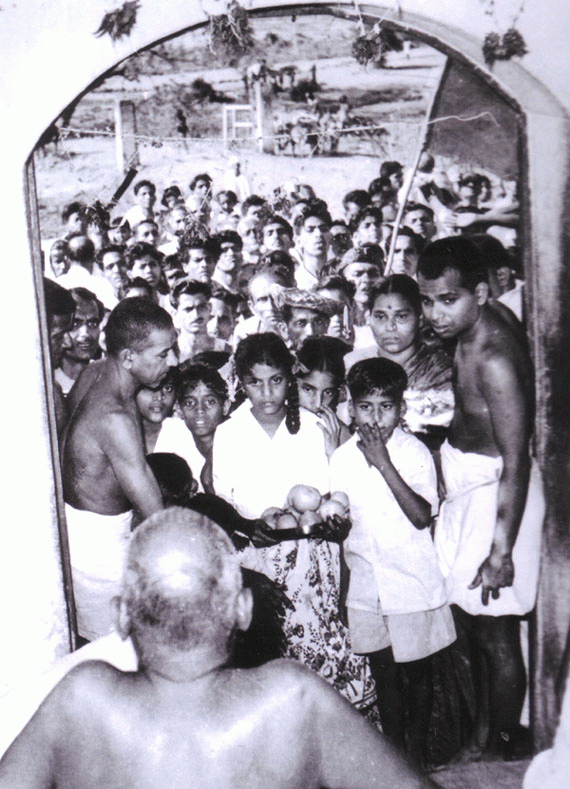
Soon great numbers began to come to
Nityananda. They had to pass through the land of a neighbor,
who began to complain about the increased traffic, and who
was even reported to have beaten and robbed devotees who
crossed his property on their way to visit the Swami. When
Nityananda heard of this, he went out and called the entire
town together. Under his direction they built a new road
around the neighbor’s property. Nityananda worked with
everyone else, doing the heaviest kind of physical labor,
cutting stones and the like. At the end of the day, he would
reach inside his loin cloth and pull out just the right
amount to pay each of his workers. If someone had worked
hard that day, Swami Nityananda would hand him more money
than those who worked little.

Nityananda home
Ganeshpuri had been the seat of
religious and spiritual activity even before Swami
Nityananda came there. One of the first projects that
Nityananda undertook was to renovate an abandoned temple
site and companion hot baths. Throughout his remaining years
at Ganeshpuri, Nityananda greatly valued these baths and
required devotees to enter them before seeing hilt.
Nityananda also frequented the baths, and his devotees noted
that often he emerged from the bathing tank completely
dry.
Nityananda admonished his devotees
to never go to the baths before four o’clock in the morning.
One morning a woman who lived in the ashram woke up at one
o’clock a.m., but thinking it to be four o’clock, she walked
down to the baths. When she arrived, she saw two bright
young men leave the bathing tank and walk into the temple.
When she reported this story to Nityananda, he told her that
she had seen two saints, and that in fact many great beings
came there to bathe. Because an encounter with these beings
could shock-the unprepared person, he had asked that no one
go to the baths while these other entities were
present.
On another occasion, a devotee who
had been up very late walked past the temple site at about
one o’clock a.m. Near the temple he spotted a huge,
eighteen-inch footprint. Astonished, he rushed to tell Swami
Nityananda what he had seen. But before he could say
anything, Nityananda asked, “Did you bow before that
footprint?”
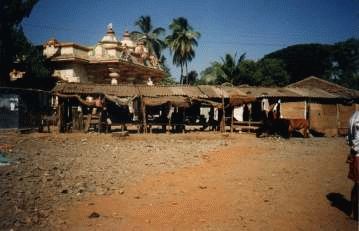
Nityananda Ashram, Ganeshpuri (early
days)
Over the years at Ganeshpuri,
Nityananda’s following grew, but his direct and simple way
of instructing devotees remained essentially the same.
People would often ask him for instruction or esoteric
practices, but he would remind them that their instruction
lay in seeing him. The devotee was to learn the practice of
love and self-transcendence by observing how their Spiritual
Master served others, how he spoke, how he lived in God
while performing all the functions of his ordinary
life.
Darshan, or formal sighting of his
physical form, was the principal form of his relationship to
devotees. Often hundreds and thousands of people walked
together for many miles in a large procession to come and
enjoy his darshan. Whole towns closed down for spiritual
celebration, and all the people of the towns paraded
together to Ganeshpuri They filed past Nityananda’s door in
large numbers, leaving gifts of flowers, fruit, and sweets.
Swami Nityananda made it known that he took care of people
while they were in procession. Despite the long distance and
occasional rainstorms, everyone always arrived in Ganeshpuri
well and happy to have a glimpse of Bhagavan Nityananda’s
radiant form.
But Nityananda’s relationship to his
devotees was not limited to those moments when they could be
in his physical company. The Captain’s mother, for example,
had not seen Swami Nityananda for many years when her son
found him at Ganeshpuri and invited her to come and see the
Swami again. The minute Nityananda saw her, he asked, “How
long since I’ve seen you?” When she replied vaguely, “Oh,
about twenty years,” he said, “No, twenty-two years.” He
told her how long it had been-to the day-since he had last
seen her, and commented on what she had done in the
interim.

Swami Nityananda was always full in
his service to devotees, and very exacting in making demands
on them. He occasionally beat people to purify them of their
tendencies. They found that even the number of times he hit
them was significant. Once he struck a devotee who was a
businessman nine times, and the man found that his $9,000
debt cleared up soon after that. In response to another
businessman who came to him for financial advice, Nityananda
only commented, “Waste, waste, waste! ” The man left,
thinking that he had been ignored by the holy man, but on
his way home he stumbled across a junkyard that was for
sale, which he purchased and which became a highly prof
itable-business.
On another occasion, a woman brought
her husband to see Swami Nityananda to be cured on a day
when the Swami had asked to be left in private. He
instructed the woman to have her husband bathe, and then to
give him a specific injection. On the way home, because he
passed the dispensary first, he stopped to have the
injection before taking. the bath. He died the moment he set
-foot in the bath, failing to follow the sequence Swami
Nityananda had given him.
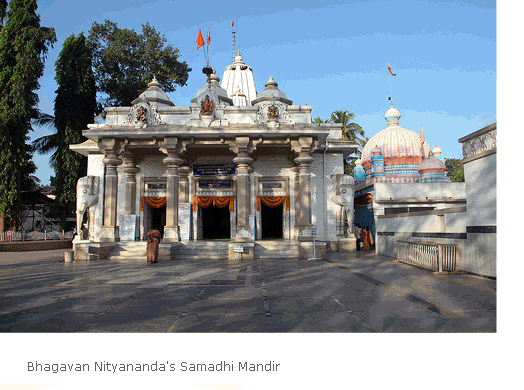
The Mahasamadhi
When Nityananda left the body in his
first but premature samadhi in 1922, he came back because he
had not yet “used up the body.” Even though he suspected
that no one would truly understand or appreciate his Divine
Incarnation, he continued to serve devotees for many years.
Finally, in 1961, his service to devotees in his physical
form was complete and he entered into
mahasamadhi.
In the two years before Swami
Nityananda died, his belly grew huge and round with
spiritual force. When devotees who did not understand the
yogic phenomenon that was manifesting in Nityananda’s body
would ask him about his size, his reply varied. To one big,
strong man who was fond of health programs and exercise,
Nityananda said that he was growing big from lack of
exercise. To another, a yogi who practiced pranayama (breath
control), he replied that he had been doing pranayama and
that, when the air was retained, his stomach became very
bloated. A third devotee, who had suffered from malaria, was
told that his huge belly was due to enlargement of the
spleen resulting from a case of malaria that Swami
Nityananda was believed to have suffered earlier in his
life. To the fourth, a very loving and devoted woman
follower, Nityananda responded that the love of all.
devotees was now concentrated in his belly and that was the
reason it had expanded.
Shortly before Swami Nityananda’s
death, signs of yogic purification began to manifest in his
body. He developed diarrhea for about four or five months
before taking his mahasamadhi, and it did not stop until he
died. A doctor who examined the Swami said that there was
nothing infectious or diseased about Nityananda’s symptoms.
Around that-same time, an odorless pus began to ooze out of
his ear. He claimed that it was due to a fall he had taken
in childhood, but his devotees, alarmed, called in a medical
specialist. The doctor was awestruck at the responsibility
of treating a holy man of Nityananda’s stature, and he
approached the saint reverently. Prostrating himself before
the Swami, the doctor told him that he could only consent to
take the case if Nityananda would promise to be cured.
Nityananda nodded, and the doctor left a medication to be
administered three times a day. When the doctor left, an
attendant asked Nityananda if he would take the pills, since
he always had refused medication. Nityananda consented and
took the first pill. Later in the day when his attendant
reminded him that he should be taking the medication several
times a day, Nityananda responded, “Not necessary. The
doctor’s faith is such that one pill has done the
job.”
Three months before his mahasamadhi,
Swami Nityananda began an all-liquid diet. He consequently
became very thin. The diet, the diarrhea, and the discharge
from his ear were all signs of a purification process that
was taking place as the Swami prepared to discard the body.
In the months prior to his death, Nityananda alluded to his
departure several times. He told his devotees that a
procession of 100,000 people would soon come to Ganeshpuri,
even though it was during the monsoon. His devotees, not
understanding his allusion, never inquired further. It is
only in retrospect that they understood what he had
foretold.
Captain Hatengdi described the event
of Swami Nityananda’s mahasamadhi as it was told to him by
one of the trustees of the ashram, who was present. On
Tuesday morning, August 8, 1961, the trustee, who had
extended his weekend stay because Nityananda’s condition
looked serious, went to offer his salutations to his Master.
When he arrived, he found Nityananda gasping for breath. A
medical team was present trying to administer oxygen. At
nine o’clock, Nityananda asked that the oxygen be removed,
The room became very quiet.
There were twelve intimate devotees
present watching their Master closely. At nine
thirty-five,’he started breathing so deeply that his chest
expanded out of proportion. After breathing in this
exaggerated manner for about an hour, at ten forty Swami
Nityananda straightened out his feet and legs (which had
been bent for some time due to arthritis) and placed his
hands over his heart. He opened his eyes very wide and
looked at everyone. Then his eyeballs rolled up, and he made
a snore-like sound and left his body.
After Swami Nityananda entered
mahasamadhi, his body was displayed for devotees to see one
last time. As he predicted, 100,000 people came in
procession to honor him in samadhi. After several days, he
was buried in an airtight cement tomb. (In India only great
beings are buried. All others are cremated.) Swami
Nityananda’s body was placed cross-legged in his favorite
chair and then covered with diamonds, sapphires, camphor,
and ash.
Before Swami Nityananda took his
mahasamadhi, he told his devotees that he could now do more
work in his astral form. Several years later, in 1969, Da
Free John contacted Swami Nityananda’s Transcendental
Presence at the site of his samadhi. Swami Nityananda later
appeared to Da Free John several times in dreams and subtle
vision.4 He led him through the higher aspects of
mystical experience that had been awakened in Da Free John
by his earlier teachers and toward true Self-Realization
in-God.
Since that time, Da Free John has
often spoken highly of Swami Nityananda, calling him a great
yogi-saint. Swami Nityananda also maintained a very active
influence in the lives of his devotees after his death.
Captain Hatengdi told us that he had felt his relationship
to Swami Nityananda intensify after the saint had passed on.
He said that only after Nityananda’s death did many of the
people who had been around him become sensitive to the
profound nature of his spiritual Presence.
Thus, Swami Nityananda surrendered
in service to his devotees even after death as he had during
his lifetime. The mood that he had always communicated was
not the rigid, ascetic disposition that one might expect of
a traditional Eastern figure. Swami Nityananda was Alive in
God! Even though he did live an austere and celibate life,
his constant occupation was one of the pleasure, love,
fullness, and humor of life lived in God. It was that
fullness, that humor, that delight in God that is Bhagavan
Nityananda’s legacy to devotees,: and to all who are
inspired by the stories of his life.
1. The death of a
saint is regarded, in India especially, as a unique event.
The saint consciously leaves the body and enters into
mahasamadhi, perfect absorption in the Divine Condition,
free of physical embodiment.
2. Sri Ramakrishna was
a great devotee of God who flourished in the mid-nineteenth
century and passed on in 1886. Vivekananda was the prominent
disciple of Sri Ramakrishna.
3. Krishna, along with
Jesus and Gautama, is one of the great archetypal examples
of the Divine Man and the true Spiritual Master. Krishna is
said to have lived at least 4,000 years ago, although we
have no certain historical data on his life and Teaching. In
the legends and myths of his life, Krishna, the living
Spiritual Master, always teaches the transcendence of all
experience through ecstatic devotion-to Himself as the
Divine Person. Through both miraculous and ordinary means,
he always is shown attracting the ecstatic love of devotees.
Arjuna was his principal devotee.
4. Da Free John, The
Knee of Listening (Middletown, CA: The Dawn Horse Press,
1972), pp. 122-30.
End of
Article
The
following was added by Beezone
Captain M.U. Hatengdi is a
retired naval secretary at the Naval headquarters in New
Delhi. He first met Bhagawan Nityananda when he was 5 years
old in 1920 in Mangalore. Had his first darshan in June of
1943. At that time he became Bhagawan Nityananda’s disciple.
After that Hatengdi spent almost every weekend with
Bhagawan. Once Captain Hatengdi hurt his toe and it was
bleeding profusely. All of a sudden Baba came into his room
and, without saying a word, Baba poured sandalwood oil over
the wound. Sandalwood oil is very soothing. Baba often knew
his disciples’ suffering and came to their aide in this way,
without being told the circumstance.
Captain Hatengdi is one of the last,
living elder disciples of Bhagawan Nityananda who had the
privilege of keeping Shri Gurudev’s company and observing
many of Bade Baba’s leelas. He has many stories to
share.
The following is from a post written
by Captain M.U. Hatengdi for a book he was writing. Captain
Hatengdi had several personal experiences with Bhagavan.
Here is his note:
GURUDEV NITYANANDA: A
personal account
Nityananda was a Master
extraordinary and portraying Him is no easy task. In some
respects, He resembled Shirdi Sai Baba and in other, Sri
Ramakrishna and perhaps Babaji, of Swami Yogananda’s
famous autobiography. In the absence of authentic details on
such limiting factors as parentage or antecedents, he
resembled Babaji and Sai Baba. In his mystic powers working
at several places at the same or various times, unknown to
anyone, he resembled Babaji and in his experiences of cosmic
consciousness, pithy sayings and homely analogies and his
strong aversion to dry discussion based on mere book
knowledge, he reminds us of Sri Ramakrishna. And finally, in
his silence, he reminds us of Sri Ramana Maharshi of
Tiruvanamalai.
Nityananda was a born Siddha. His
total self-abnegation (he wore a mere langoti all his life
and had no possessions whatsoever), absence of any earthly
Guru or known performance of Sadhana or formal worship in
any temple, his felicity to communicate in many languages,
including English, his ability to understand other
creatures, his omniscience as regards the past, present and
the future of individual, local and world affairs, his
intimate knowledge of spiritual, historical and political
personalities, knowledge of unheard of remedies, only
underscore this fact.
On no single occasion either in his
youth or later in Ganeshpuri, was he ever found using the
first person Singular (“I”) in reference to
himself. It would always be ‘this one’ and
‘from here’. Behind his rather awe-inspiring
presence, was the heart and compassion of a mother. No
wonder, as a full-fledged Master while hardly out of his
teens, in Kanhangad and South Kanara, in the pre-twenties
and early thirties, he would compare Sadhus (the
denomination by which he was referred to in those days) to a
jackfruit, with its forbidding exterior and sticky interior,
but which when penetrated with skill, yielded its honeyed
sweetness inside. From those early days to his last ones at
Ganeshpuri, his concern for the lowly, those in distress and
the children, was unbounded. And he missed no opportunity in
feeding them. Even today, some 700-800 poor children of the
local tribals, are fed with one free meal every morning,
near his Samadhi shrine at Ganeshpuri, with ever-flowing
unsolicited funds received specifically for this purpose.
Even though people in their vast
multitudes from all walks of life, including foreigners,
went for his darshan very few were moved to record their
experiences or remember the details for the benefit of
others. The situation was further confused by his silence
towards the general public and the resultant anonymity
surrounding his physical manifestation, movements or
activities.
He was not an organization man; nor
had he any gospel to be spread. But he was a great radiating
and transmitting centre. As Swami Vivekananda said,
spiritual knowledge cannot be taught like history or
mathematics, but can only be transmitted like heat and
light. Perhaps it is for this purpose that Nityananda asked
everyone to cultivate Shuddha Bhavana and Shraddha, so that
the ‘door’ may be opened for Him to enter and
gradually transform the aspirant from within.
A prince amoung renunciates, he
needed no gifts or estate, and what was offered was ether
distributed utilized for the common good and the rest left
unsecured. He was at once the friend of the poor and of
those in distress; the spiritual aspirant’s guide and
the devotee’s eternal companion. His grace emanated
from his presence. Swami Vivekananda defined grace thus:
“Grace means this: He who has realized the Atman
becomes a store-house of great power. Making him the centre
and with a certain radius a circle is formed, and whoever
comes within the circle becomes animated with the ideas of
that saint, i.e., they are overwhelmed by his ideas. Thus
without much religious striving they inherit the results of
his wonderful spiritual ity. If you call this Grace, you may
do so. “Sri Ramakrishna says that when such
Ishwar-kotis attain Mahasamadhi, it is like their hiding in
an attic!
Nityananda consoled a grieving
devotee, who had an intuitive premonition of his passing
away about three months prior to the event, by assuring her
that more was possible in the subtle than in the gross.
Today, almost all of the hundreds of devotees who pay homage
at his Samadhi shrine daily, would have never seen him in
his human form. Yet when you enquire of them as to what
prompts them to come, each one has a tale to tell in which
some distress was relieved, guidance received or elevation
of spirit experienced.
–Captain M U Hatengdi, (retd Indian
Navy)
Devotees’ Stories
Early Days in Ganeshpuri
As word spread of Nityananda’s
arrival, villagers from surrounding areas began gathering
around his hut in the evenings. A large pot of rice
porridge, of which the Master would partake, always stood
ready for them. Devotees were soon flocking to Ganeshpuri as
well. To accomodate them, a building was constructed east of
the hot spring tanks.
At first, due to a lack of potable
water, visitors only stayed the day. However, once the old
well was refurbished, sulfur water was used for everything.
One particularly hot afternoon the Master offered a plate of
rice with spicy pickle sauce to a visiting devotee. It so
happened that the woman foudn sulfur water distasteful and
declined the food, knowing that she would crave something to
drink afterward. Nityananda again held out the plate to her,
saying, “Don’t be concerned. You will drink rain water.”
Venturing a look at the blue sky, she still ate nothing.
Within minutes, however,a solitary cloud appeared overhead
and rain poured down. The Master said, “Go and get your
water,” and she jumped up and collected rain water for both
of them.
Devotees gathered late one evening
on the west side of the ashram. Here Nityananda sat on a
small ledge bordering a six-foot drop into the darkening
fields behind him. Silence prevailed. Suddenly in the
distance a pair of bright eyes appeared and, weaving its way
slowly through the fields, a tiger came up to the ledge and
stopped. The animal then rose lightly on its haunches and
rested its forepaws on Nityananda’s shoulders. Calmly
the Master reached up with his right hand and stroked the
tiger’s head. Satisfied, the tiger jumped back down and
disappeared into the night. Later Nityananda observed that
as the vehicles of the Goddess Vajreshwari, tigers should be
expected around her temple. He also said that wild beasts
behave like lambs in the presence of enlightened
beings.
Many stories tell of his uncanny
ability to understand animals. In Udipi once he told its
captors to release a certain caged bird because it
constantly cursed them. Another time he reassured a
frightened devotee that a nearby cobra was too busy chanting
to harm anybody. Others remember a devotee who always came
for darshan accompanied by his pet parrot. And in May 1944,
Captain Hatengdi heard Nityananda say that a bird told him
that it would rain in three days, and rain it did.
Nityananda’s Life
Nityananda lived from the late
nineteenth century to 1961, making him one of India’s most
recent extraordinary saints. Nonetheless, information about
his birth and early childhood is sparse and contradictory.
It has been said that as an infant he was found in the
Guruvan jungle by a harijan woman. This woman sold the baby
to the childless Unniamma of Calicut, a simple woman who
earned a small income by doing household work for Ishwar
Iyer, a prominent solicitor. This kind, devout man took an
interest in the youngster, who was named Ram by his adoptive
mother. Upon her death, he assumed guardianship of the
child.
Occasional remarks made by
Nityananda through the years, however, support another
version: protected by a large serpent coiled around him, the
baby was found on a riverbank and cared for by the
kind-hearted but poor Unniamma, here married with several
children of her own. Ishwar Iyer, again Unniamma’s employer,
took the orphaned Ram upon her death.
It is generally agreed that Ram, as
he was then called, left his home with Mr. Iyer following a
trip the two took together to Varanasi. He was then perhaps
in his early teens and it is known that he traveled widely
during this period. While it is impossible to reconstruct an
itinerary, it is thought that he spent considerable time in
the Himalayas and in many holy places in north India. When
his foster father lay dying, Nityananda returned to Calicut
to be with him. Following the funeral, Nityananda again
departed for a period of wondering in south India, and
stories exist of even more far-ranging travel: to Singapore,
Malaysia, even Japan.
Around 1910 stories begin placing
the young Nityananda in the South Kanara district of North
Kerala. This was a time of miracles and of growing
recognition that an exceptional being was present.
Historically, Nityananda was discovered in Udipi in 1918 by
two gentlemen who remained life-long devotees.
During this period Nityananda
traveled a great deal. He also spent time in contemplation
at Guruvan, the jungle where he was found as an infant. For
a time he stayed a few miles nearer the sea at Kanhangad,
starting several substantial building projects and working
on the rock-cut caves for which the area is famous. By now
he was quite well known and an ashram was developing around
him. Today we find temples to his honor at both Guruvan and
Kanhangad.
In the 1920s Nityananda spent time
in Mangalore. Nityananda had many devotees here and it was
his custom to stay with a devotee family in the town. During
this time, Nityananda allowed devotees to gather around him
in the evenings and sit in silence. Occasionally, however,
Nityananda would speak from a trance-like state, and
eventually devotees began to copy down his words. The many
different transcribers spoke different dialects and had
varying levels of education. Sometimes his words were not
recorded until after Nityananda had stopped speaking for the
evening. Years later, these notes, in their various formats
and languages were gathered together and compiled by a
persevering devotee and published in the Kanarese dialect.
The words of Nityananda were eventually translated into
English.
In the mid-1930s he settled in a
jungle near Bombay called Ganeshpuri. There he remained for
almost 30 years, until his mahasamadhi in 1961. His
reputation grew steadily during this time, drawing crowds to
his tiny place in the jungle. Initially, he stayed at a very
old Shiva temple called the Bhimeshwari temple. Built in the
sixth or seventh century, the site was overgrown by
vegetation and inhabited by snakes and tigers. Nityananda
cleared it out and settled into this simple temple, which
was just a hollow place lined with stones and covered with a
roof. In the center of the floor stood a round stone pillar
called a lingham. Villagers would pour water over it and
decorate it with flowers and kumkum, the vermilion powder
used in worship and ceremonies. The lingham is the symbol of
Shiva’s pure potential. And because Nityananda was there,
the sixty or seventy miles surrounding Ganeshpuri were
transformed from a jungle to a place where the ground was
cultivated and educated people came to live.
More on Nityananda’s life from
Non-duality
Press
Nityananda:
In Divine Presence